Trajectory of Teacher Well-Being Research between 1973 and 2021: Review Evidence from 49 Years in Asia
Abstract
:1. Introduction
- To what degree has the volume of teacher well-being research progressed and how has it progressed in terms of publication level, research localities, and research matters between the years of 1973 and 2021 in Asia?
- To what extent has the distribution of research type (e.g., empirical, theoretical, and review) of teacher well-being research evolved, and in which ways have they evolved in the period 1973 to 2021 in Asia?
- To what extent have the research methods (e.g., qualitative methods, quantitative methods, and mixed methods) that academics employ in TWB research advanced from 1973–2021 in countries located in Asia?
2. Relevance of Investigating Teacher Well-Being in the Asian Context
3. Method
3.1. Inclusion and Exclusion Criteria
3.2. Literature Search and Study Identification
3.3. Data Screen and Extraction
3.4. Data Analysis
4. Findings
4.1. Year of Publication
4.2. Data Location
4.3. Research Foci
4.4. Research Type
4.5. Research Method
5. Discussion and Future Research
5.1. Publication Year
5.2. Data Location
5.3. Research Foci
5.4. Research Type
5.5. Research Method
6. Limitations
Author Contributions
Funding
Institutional Review Board Statement
Informed Consent Statement
Conflicts of Interest
References
- McCallum, F. The changing nature of teachers’ work and its impact on well-being. In Critical Perspectives on Teaching, Learning and Leadership: Enhancing Educational Outcomes; White, M.A., McCallum, F., Eds.; Springer: Singapore, 2020; pp. 17–44. [Google Scholar]
- Capone, V.; Petrillo, G. Mental health in teachers: Relationships with job satisfaction, efficacy beliefs, burnout and depression. Curr. Psychol. 2020, 39, 1757–1766. [Google Scholar] [CrossRef]
- The Organization for Economic Co-Operation and Development. In How’s Life: Measuring Well-Being; OECD: Paris, France, 2020. [CrossRef]
- The World Health Organization. Preamble, Constitution of the World Health Organization (as Adopted by the International Health Conference, New York, 19–22 June 1946; Signed on 22 July 1946 by the Representatives of 61 States). 1946. Available online: http://whqlibdoc.who.int/hist/official_records/constitution.pdf (accessed on 6 March 2022).
- Van Petegem, K.; Creemers, B.; Rossel, Y.; Aelterman, A. Relationships between teacher characteristics, interpersonal teacher behaviour and teacher well-being. J. Classr. Interact. 2005, 40, 34–43. [Google Scholar]
- Acton, R.; Glasgow, P. Teacher well-being in neoliberal contexts: A review of the literature. Aust. J. Teach. Educ. 2015, 40, 99–114. [Google Scholar]
- Hascher, T.; Waber, J. Teacher well-being: A systematic review of the research literature from the year 2000–2019. Educ. Res. Rev. 2021, 34, e100411. [Google Scholar] [CrossRef]
- McCallum, F. Teachers’ well-being during times of change and disruption. In Well-Being and Resilience Education: COVID-19 and Its Impact On Education; White, M.A., McCallum, F., Eds.; Routledge: London, UK, 2021; pp. 183–209. [Google Scholar]
- Viac, C.; Fraser, P. Teachers’ Well-Being: A Framework for Data Collection and Analysis; OECD: Paris, France, 2020. [CrossRef]
- Dimmock, C.; Walker, A. Globalization and societal culture: Redefining schooling and school leadership in the twenty-first century. Compare A J. Compar. Int. Edu. 2000, 30, 303–312. [Google Scholar] [CrossRef]
- Tan, C.; Chua, C.S.K. Education policy borrowing in China: Has the west wind overpowered the east wind? Compare A J. Compar. Int. Edu. 2015, 45, 686–704. [Google Scholar]
- Chen, J. Research review on teacher emotion in Asia between 1988 and 2017: Research topics, research types and research methods. Front. Psychol. (Sec. Educ. Psychol.) 2019, 10, 1628. [Google Scholar] [CrossRef]
- Hascher, T.; Beltman, S.; Mansfield, C. Teacher well-being and resilience: Towards an integrative model. Educ. Res. 2021, 63, 416–439. [Google Scholar] [CrossRef]
- Hallinger, P.A. Meta-Synthesis of Bibliometric Reviews of Research on Managing for Sustainability, 1982–2019. Sustainability 2021, 13, 3469. [Google Scholar] [CrossRef]
- Murphy, J.; Vriesenga, M.; Storey, V. Educational Administration Quarterly, 1979–2003: An analysis of types of works, methods of investigation, and influences. Educ. Admin. Q. 2007, 43, 612–628. [Google Scholar] [CrossRef]
- Hallinger, P.; Kovačević, J. A Bibliometric Review of Research on Educational Administration: Science Mapping the Literature, 1960 to 2018. Rev. Educ. Res. 2019, 89, 335–369. [Google Scholar] [CrossRef]
- McCallum, F.; Price, D. Nurturing Well-Being Development in Education: From Little Things, Big Things Grow, 1st ed.; Routledge: London, UK, 2015. [Google Scholar]
- Tang, Y.; He, W.; Liu, L.; Li, Q. Beyond the paycheck: Chinese rural teacher well-being and the impact of professional learning and local community engagement. Teach. Teach. 2018, 24, 825–839. [Google Scholar] [CrossRef]
- Brunzell, T.; Stokes, H.; Waters, L. Why do you work with struggling students? Teacher perceptions of meaningful work in trauma-impacted classrooms. Aust. J. Teach. Educ. 2018, 43, 116–142. [Google Scholar] [CrossRef]
- Edara, I.R.; del Castillo, F.; Ching, G.S.; del Castillo, C.D. Religiosity and contentment among teachers in the Philippines during covid-19 pandemic: Mediating effects of resilience, optimism, and well-being. Religions 2021, 12, 879. [Google Scholar] [CrossRef]
- Hidayat, R.; Moosavi, Z.; Hadisaputra, P. Achievement goals, well-being and lifelong learning: A mediational analysis. Int. J. Instr. 2022, 15, 89–112. [Google Scholar]
- Renshaw, T.L.; Long, A.C.; Cook, C.R. Assessing teachers’ positive psychological functioning at work: Development and validation of the Teacher Subjective Well-being Questionnaire. Sch. Psychol. Q. 2015, 30, 289–306. [Google Scholar] [CrossRef]
- Hu, D.; Zhou, T.; Zhou, K.; Deng, F. The relationship between psychological capital and teacher career commitment in ethnic areas of China: The mediating effects of gratitude and career well-being. Front. Psychol. 2022, 12, e818274. [Google Scholar] [CrossRef]
- Kumar, S.P. Influence of University teachers’ job satisfaction on subjective well-being and job performance. J. Eng. Educ. Transform. 2022, 35, 160–167. [Google Scholar] [CrossRef]
- Cherkowski, S.; Walker, K.D. Teacher Well-Being: Noticing Nurturing, Sustaining and Flourishing in Schools; Word & Deed Publishing: Burlington, ON, Canada, 2018. [Google Scholar]
- School Mental Health Group. Teachers’ Lack of Well-Being and Mental Ill-Health in Schools. 2019. Available online: https://teachwellallliance.com/research-teachers-and-well-being (accessed on 6 March 2022).
- Cumming, T. Early childhood educators’ well-being: An updated review of the literature. Early Child. Educ. J. 2017, 45, 583–593. [Google Scholar] [CrossRef]
- Zee, M.; Koomen, H.M.Y. Teacher self-efficacy and its effects on classroom processes, student academic adjustment, and teacher well-being. Rev. Educ. Res. 2016, 86, 981–1015. [Google Scholar] [CrossRef]
- Choy, G. Stress among Hong Kong’s Students and Teachers Has Risen to Worrying Levels during the Coronavirus Pandemic, Local Groups Say. 2021. Available online: https://www.scmp.com/news/hong-kong/education/article/3130023/stress-among-hong-kongs-students-and-teachers-has-risen (accessed on 21 January 2022).
- Carreon, T.; Rotas, E.; Cahapay, M.; Garcia, K.; Amador, R.; Anoba, J.L. Fear of COVID-19 and remote teaching burnout of Filipino K to 12 teachers. IJERI-Int. J. Educ. Res. Innov. 2021, 4, 552–567. [Google Scholar] [CrossRef]
- Schutz, P.; Rodgers, K.; Simcic, J. Motivation and emotional transactions: Where do we go from here? In The Decade Ahead: Applications and Contexts of Motivation and Achievement; Urdan, T.C., Karabenick, S.A., Eds.; Emerald Group Publishing Limited: Bingley, UK, 2010; pp. 43–68. [Google Scholar]
- Schroeder, L. What High-Stakes Testing Means for the Emotional Well-Being of Students and Teachers. Ph.D. Thesis, Graduate University, Claremont, CA, USA, 2006. Unpublished. [Google Scholar]
- Srinivasan, P. Exploring the influences of teacher’s intelligence and emotional intelligence on students’ academic achievement. Am. J. Edu. Res. 2015, 3, 1159–1162. [Google Scholar]
- Schutz, P.A.; Quijada, P.D.; de Vries, S.; Lynde, M. Emotion in educational contexts. In International Encyclopedia of Education, 3rd ed.; McGaw, B., Peterson, P.L., Baker, E., Eds.; Elsevier Inc: Oxford, UK, 2010; pp. 591–596. [Google Scholar]
- Behrent, M. Reclaiming our freedom to teach: Education reform in the Obama era. Harv. Educ. Rev. 2009, 79, 240–246. [Google Scholar] [CrossRef]
- Valli, L.; Buese, D. The changing roles of teachers in an era of high-stakes accountability. Am. Educ. Res. J. 2007, 44, 519–558. [Google Scholar] [CrossRef]
- Thompson, G. NAPLAN, My School and accountability: Teacher perceptions of the effects of testing. Int. Educ. J. Comp. Perspect. 2014, 12, 62–84. [Google Scholar]
- Oades, L.G.; Baker, L.M.; Francis, J.J.; Taylor, J.A. Well-being Literacy and Positive Education. In The Palgrave Handbook of Positive Education; Kern, M.L., Wehmeyer, M.L., Eds.; Palgrave Macmillan: London, UK, 2021; pp. 325–343. [Google Scholar]
- Moher, D.; Liberati, A.; Tetzlaff, J.; Altman, D.G. Preferred reporting items for systematic reviews and meta-analyses: The PRISMA statement. Ann. Int. Med. 2009, 151, 264–270. [Google Scholar] [CrossRef]
- Gupta, B.S.; Jain, T.P. A study of health status of school teachers and their health knowledge and attitude towards school health programme. 1973; 12, 268–270. [Google Scholar]
- Polanin, J.R.; Maynard, B.R.; Dell, N.A. Overviews in education research: A systematic review and analysis. Rev. Edu. Res. 2017, 87, 172–203. [Google Scholar] [CrossRef]
- Jennings, P.A.; Greenberg, M.T. The prosocial classroom: Teacher social and emotional competence in relation to student and classroom outcomes. Rev. Educ. Res. 2009, 79, 491–525. [Google Scholar] [CrossRef]
- Dietrichson, J.; Bøg, M.; Filges, T.; Jørgensen, A.M.K. Academic interventions for elementary and middle school students with low socioeconomic status: A systematic review and meta-analysis. Rev. Educ. Res. 2017, 87, 243–282. [Google Scholar] [CrossRef]
- Stone, H.; Sidel, J.; Oliver, S.; Woolsey, A.; Singleton, R.C. Sensory evaluation by quantitative descriptive analysis. In Descriptive Sensory Analysis in Practice; Gacular, M.C., Ed.; Food & Nutrition Press, Inc: Trumbull, CT, USA, 2004; pp. 23–34. [Google Scholar]
- Meng, Q. Chinese university teachers’ job and life satisfaction: Examining the roles of basic psychological needs satisfaction and self-efficacy. J. Gen. Psychol. 2022, 149, 327–348. [Google Scholar] [CrossRef]
- Greenier, V.; Derakhshan, A.; Fathi, J. Emotion regulation and psychological well-being in teacher work engagement: A case of British and Iranian English language teachers. System 2021, 97, e102446. [Google Scholar] [CrossRef]
- Li, J.B.; Yang, A.; Zhang, R.; Leung, T.Y.; Li, Z. Occupational Well-Being in Hong Kong Beginning Early Childhood Educators and the Prediction of Job-Related Factors: Variable-Centered and Person-centered Approaches. Front. Psychol. 2021, 12, e746123. [Google Scholar] [CrossRef] [PubMed]
- Kurt, G.; Demir, B.; Atay, D. An exploratory study on Turkish EFL pre-service teachers’ subjective well-being. Zb. Inst. Pedagog. Istraz. 2021, 53, 121–150. [Google Scholar] [CrossRef]
- Sun, G.; Khaskheli, A.; Raza, S.A.; Khan, K.A.; Hakim, F. Teachers’ self-efficacy, mental well-being and continuance commitment of using learning management system during COVID-19 pandemic: A comparative study of Pakistan and Malaysia. Interact. Learn. Environ. 2021, 1–23. [Google Scholar] [CrossRef]
- Alqarni, N.A. Well-being and the Perception of Stress among EFL University Teachers in Saudi Arabia. J. Lang. Educ. 2021, 7, 8–22. [Google Scholar] [CrossRef]
- Song, H.; Gu, Q.; Zhang, Z. An exploratory study of teachers’ subjective well-being: Understanding the links between teachers’ income satisfaction, altruism, self-efficacy and work satisfaction. Teach. Teach. 2020, 26, 3–31. [Google Scholar] [CrossRef]
- Ngui, G.K.; & Lay, Y.F. The Predicting Roles of Self-efficacy and Emotional Intelligence and the Mediating Role of Resilience on Subjective Well-being: A PLS-SEM Approach. Pertanika J. Soc. Sci. Hum. 2019, 27, 1–25. [Google Scholar]
- Gu, Y.; Wang, R.; You, X. Recovery experiences moderate the impact of work stressors on well-being: A two-wave study of preschool teachers. Early Child. Educ. J. 2020, 48, 189–202. [Google Scholar] [CrossRef]
- Balakrishnan, K.; Harji, M.B.; Angusamy, A. Determinants of Multicultural Identity for Well-Being and Performance. Asian J. Soc. Sci. 2020, 48, 488–512. [Google Scholar] [CrossRef]
- Klassen, R.M.; Aldhafri, S.; Mansfield, C.F.; Purwanto, E.; Siu, A.F.Y.; Wong, M.W.; Woods-McConney, A. Teachers’ engagement at work: An international validation study. J. Exp. Educ. 2012, 80, 317–337. [Google Scholar] [CrossRef]
- Wei, M.H. Multiple abilities and subjective well-being of Taiwanese kindergarten teachers. Soc. Behav. Personal. An. Int. J. 2013, 41, 7–16. [Google Scholar] [CrossRef]
- Cheng, L.; Lam, C.Y. The worst is yet to come: The psychological impact of COVID-19 on Hong Kong music teachers. Music Educ. Res. 2021, 23, 211–224. [Google Scholar] [CrossRef]
- Ratanasiripong, P.; Ratanasiripong, N.T.; Nungdanjark, W.; Thongthammarat, Y.; Toyama, S. Mental health and burnout among teachers in Thailand. J. Health Res. 2022, 36, 404–416. [Google Scholar] [CrossRef]
- Fu, W.; Wang, C.; Tang, W.; Lu, S.; Wang, Y. Emotional Intelligence and Well-Being of Special Education Teachers in China: The Mediating Role of Work-Engagement. Front. Psychol. 2021, 12, e696561. [Google Scholar] [CrossRef]
- Cho, H. Power of good old days: How leisure nostalgia influences work engagement, task performance, and subjective well-being. Leis. Stud. 2021, 40, 793–809. [Google Scholar] [CrossRef]
- Rafsanjani, M.A.; Hakim, L.; Laily, N.; Wijaya, P.A.; Irwansyah, M.R. Exploring the predictor of innovative teaching using the job demands-resources model. Образoвание и Наука. 2021, 23, 58–74. [Google Scholar] [CrossRef]
- Zach, S.; Inglis, V. The relationships between personality traits, subjective well-being, and academic achievements among physical education teacher education students. J. Cogn. Educ. Psychol. 2019, 18, 52–66. [Google Scholar] [CrossRef]
- Asl Marz, F.; Asl Marz, M.; Gholami, A.A.; Azizi, M.G. Analysis of Mental Health and Well-being of High School Teachers and Its Effect on Emotional and Disciplinary Relationships of High School Students in Ilam. J. Qual. Res. Health Sci. 2021, 10, 338–350. [Google Scholar]
- Karakus, M.; Ersozlu, Z.; Usak, M.; Ocean, J. Self-Efficacy, Affective Well-Being, and Intent-to-Leave by Science and Mathematics Teachers: A Structural Equation Model. J. Balt. Sci. Educ. 2021, 20, 237–251. [Google Scholar] [CrossRef]
- Chen, J. A descriptive review of research published on teacher emotion in Asia 1990–2019. In Emotions in Learning, Teaching & Leadership: Asian Perspectives; Chen, I.J., King, R.B., Eds.; Taylor & Francis Group, Routledge: Singapore, 2020; pp. 78–92. [Google Scholar]
- Bricheno, P.; Brown, S.; Lubansky, R. Teacher Well-Being: A Review of the Evidence; Teacher Support Network: London, UK, 2009. [Google Scholar]
- Kong, X. Chinese English as a foreign language teachers’ self-efficacy and psychological well-being as predictors of their work engagement. Front. Psychol. 2021, 12, e788756. [Google Scholar] [CrossRef]
- Zhu, X.; Tian, G.; Yin, H.; He, W. Is familism a motivator or stressor? Relationships between Confucian familism, emotional labour, work-family conflict, and emotional exhaustion among Chinese teachers. Front. Psychol. 2021, 12, e766047. [Google Scholar] [CrossRef] [PubMed]
- Kong, S.; Wong, W. Stressors and psychological distress: Music listening as a coping strategy for pre-service kindergarten teachers. Int. J. Music Educ. 2021, 40, 260–275. [Google Scholar] [CrossRef]
- Tsang, K.K.Y.; Shum, K.K.; Chan, W.W.L.; Li, S.X.; Kwan, H.W.; Su, M.R.; Wong, B.P.H.; Lam, S. Effectiveness and mechanisms of mindfulness training for school teachers in difficult times: A randomized controlled trial. Mindfulness 2021, 12, 2820–2831. [Google Scholar] [CrossRef] [PubMed]
- Seo, S.; Yuh, J. Mindfulness and resilience as mediators in the relationship between job-related stress and teacher–child interaction among early childhood educators. Early Child. Educ. J. 2022, 50, 1209–1219. [Google Scholar] [CrossRef]
- Fraschini, N.; Park, H. Anxiety in language teachers: Exploring the variety of perceptions with Q methodology. Foreign Lang. Ann. 2021, 54, 341–364. [Google Scholar] [CrossRef]
- Hall-Kenyon, K.M.; Bullough, R.V.; MacKay, K.L.; Marshall, E.E. Preschool teacher well-being: A review of the literature. Early Child. Educ. J. 2014, 42, 153–162. [Google Scholar] [CrossRef]
- Tam, P.C. Response to COVID-19 ‘Now I send you the rays of the sun’: A drama project to rebuild post-COVID-19 resilience for teachers and children in Hong Kong. Res. Drama Educ. J. Appl. Theatre Perform. 2020, 25, 631–637. [Google Scholar] [CrossRef]
- McCallum, F.; Price, D.; Graham, A.; Morrison, A. Teacher Well-Being: A Review of the Literature. 2017. Available online: https://apo.org.au/node/201816 (accessed on 6 March 2022).
- Edmondson, A.C.; McManus, S.E. Methodological fit in management field research. Acad. Manag. Rev. 2007, 32, 1246–1264. [Google Scholar] [CrossRef]
- Creswell, J.W.; Clark, V.L.P. Designing and Conducting Mixed Methods Research, 3rd ed.; SAGE: Thousand Oaks, CA, USA, 2017. [Google Scholar]
- Phelps, E.A.; Sharot, T.S. How (and why) emotion enhances the subjective sense of recollection. Curr. Dir. Psychol. 2008, 17, 147–152. [Google Scholar] [CrossRef]
- Chen, J.; Cheng, T.J. Review of research on teacher emotion during 1985-2019: A descriptive quantitative analysis of knowledge production trends. Eur. J. Psychol. Educ. 2021, 37, 417–438. [Google Scholar] [CrossRef]
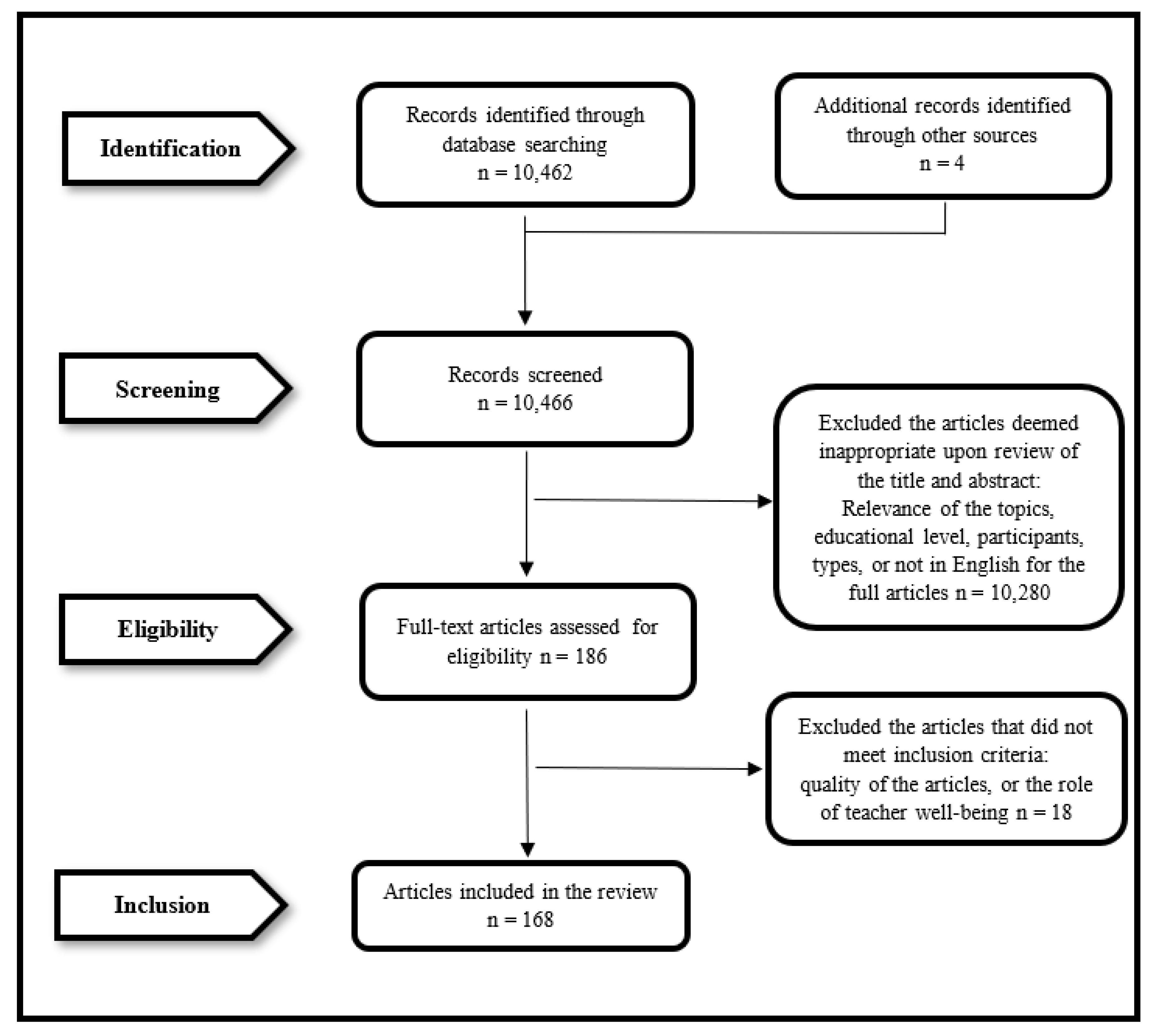
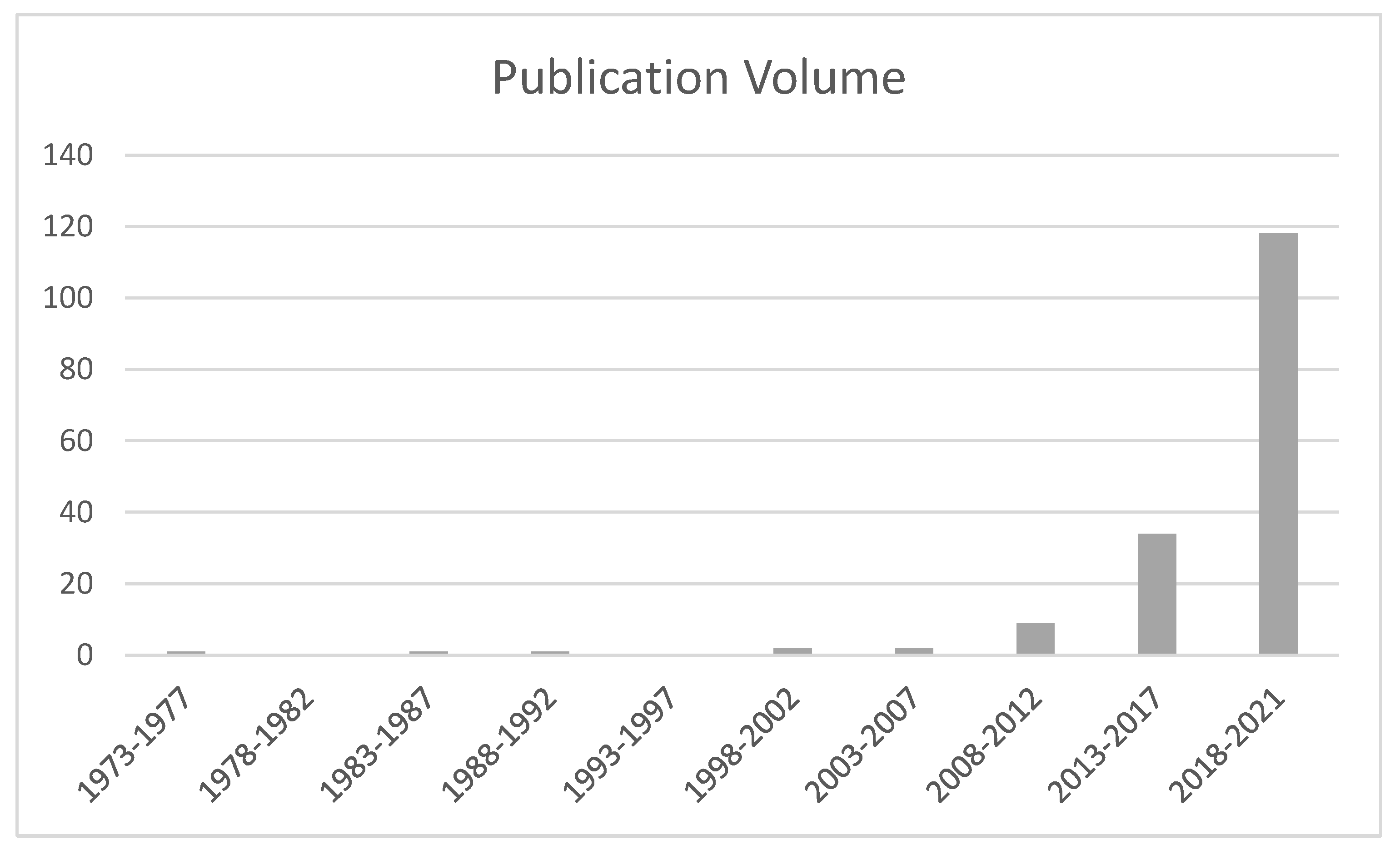
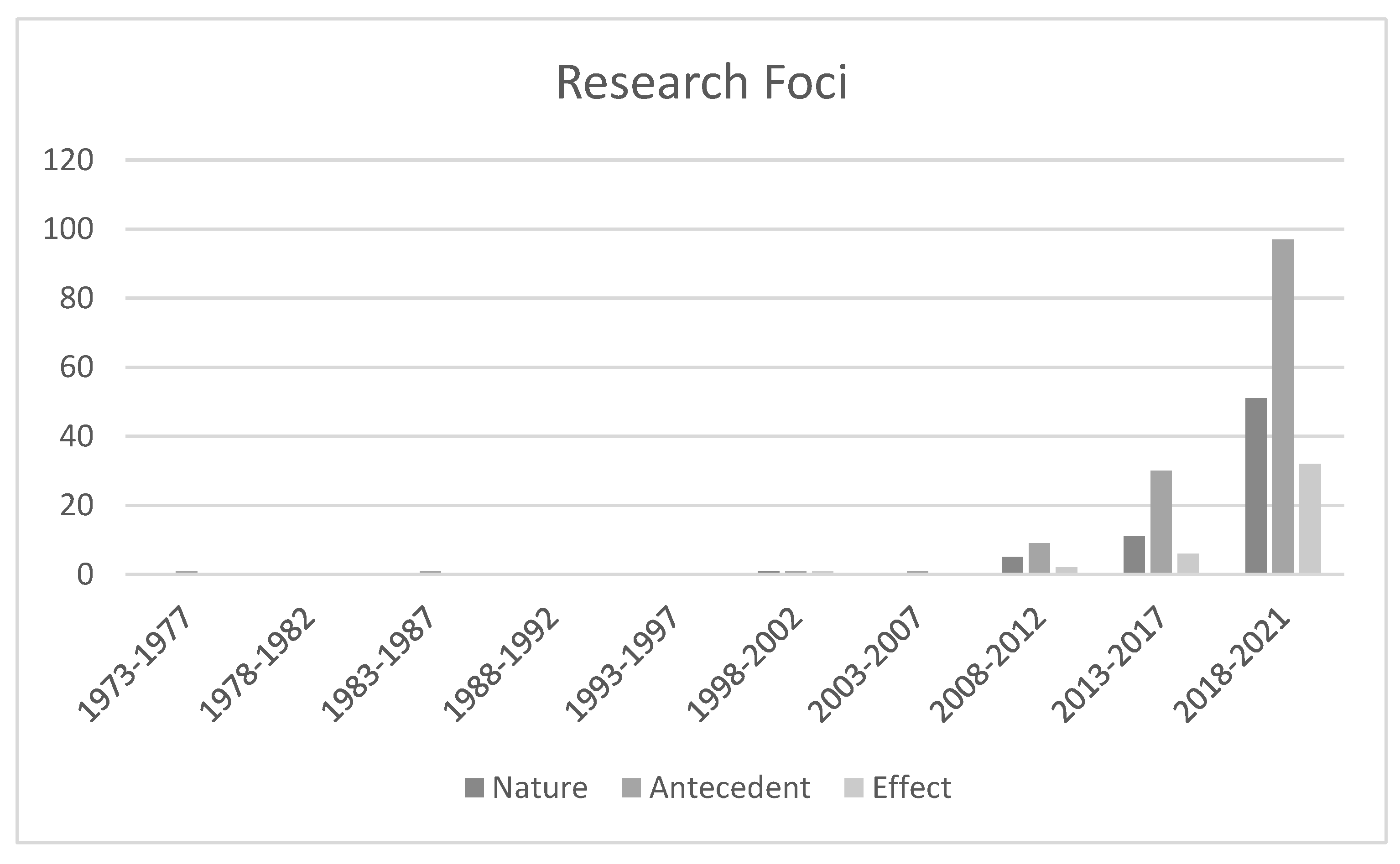
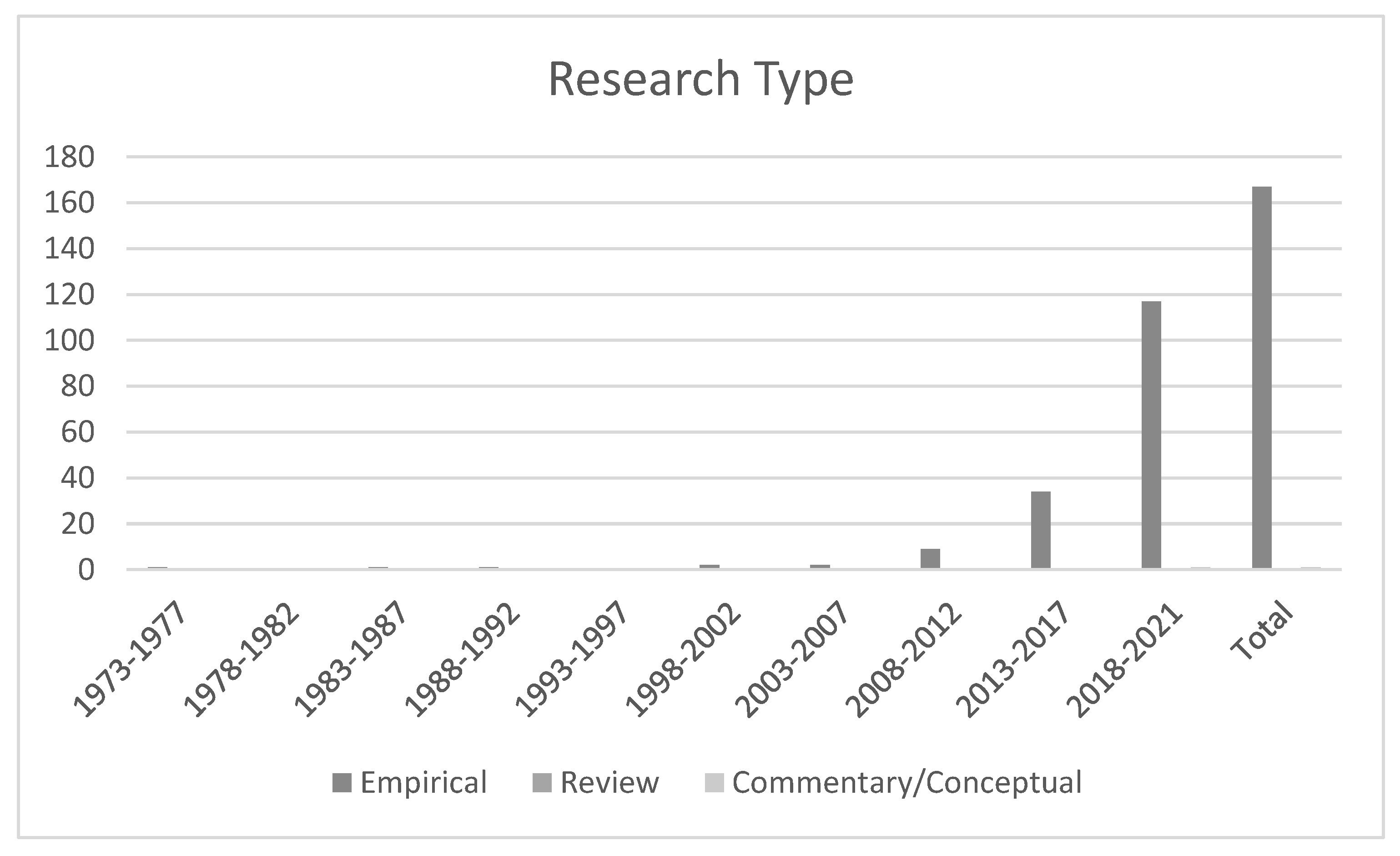
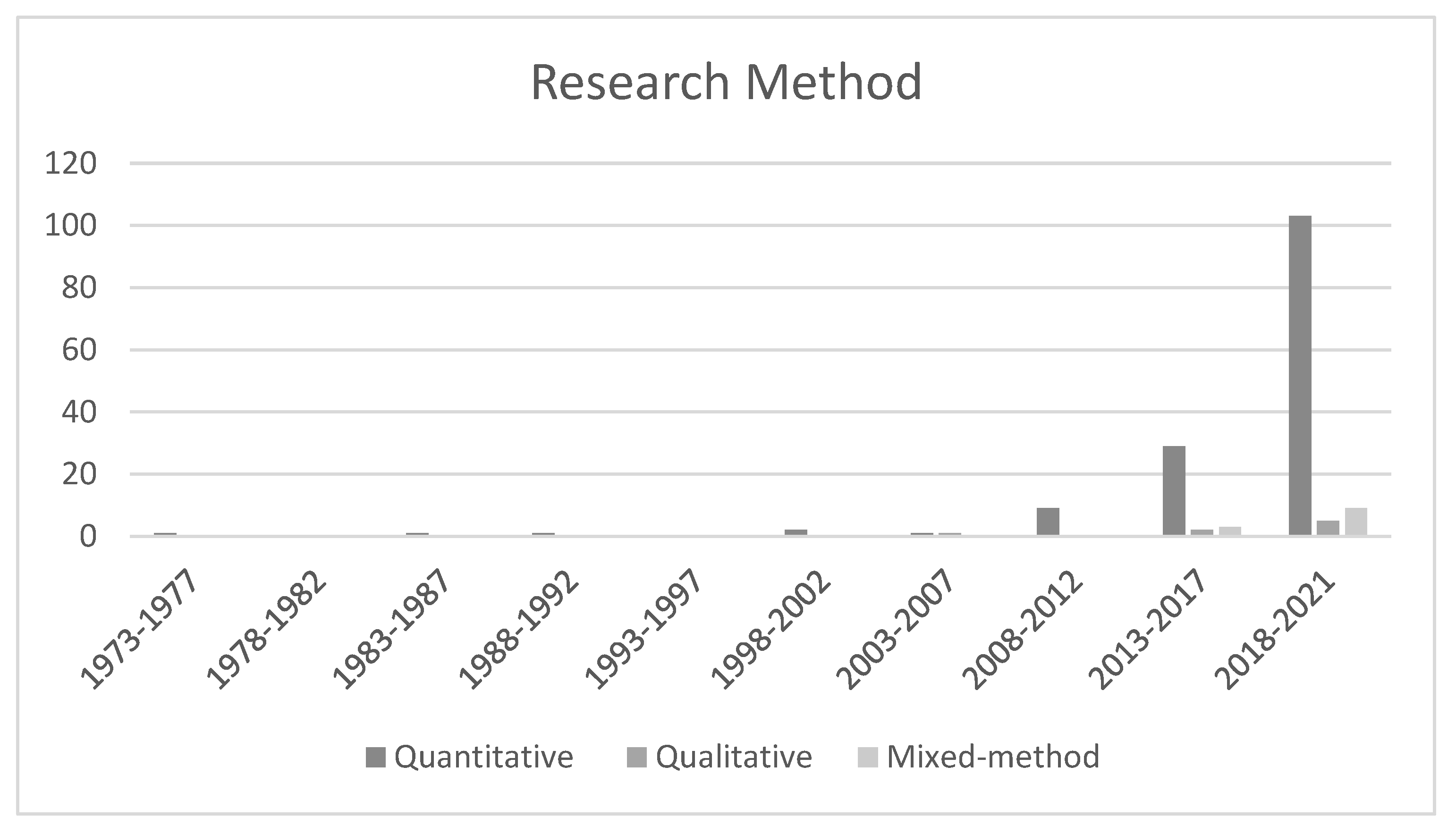
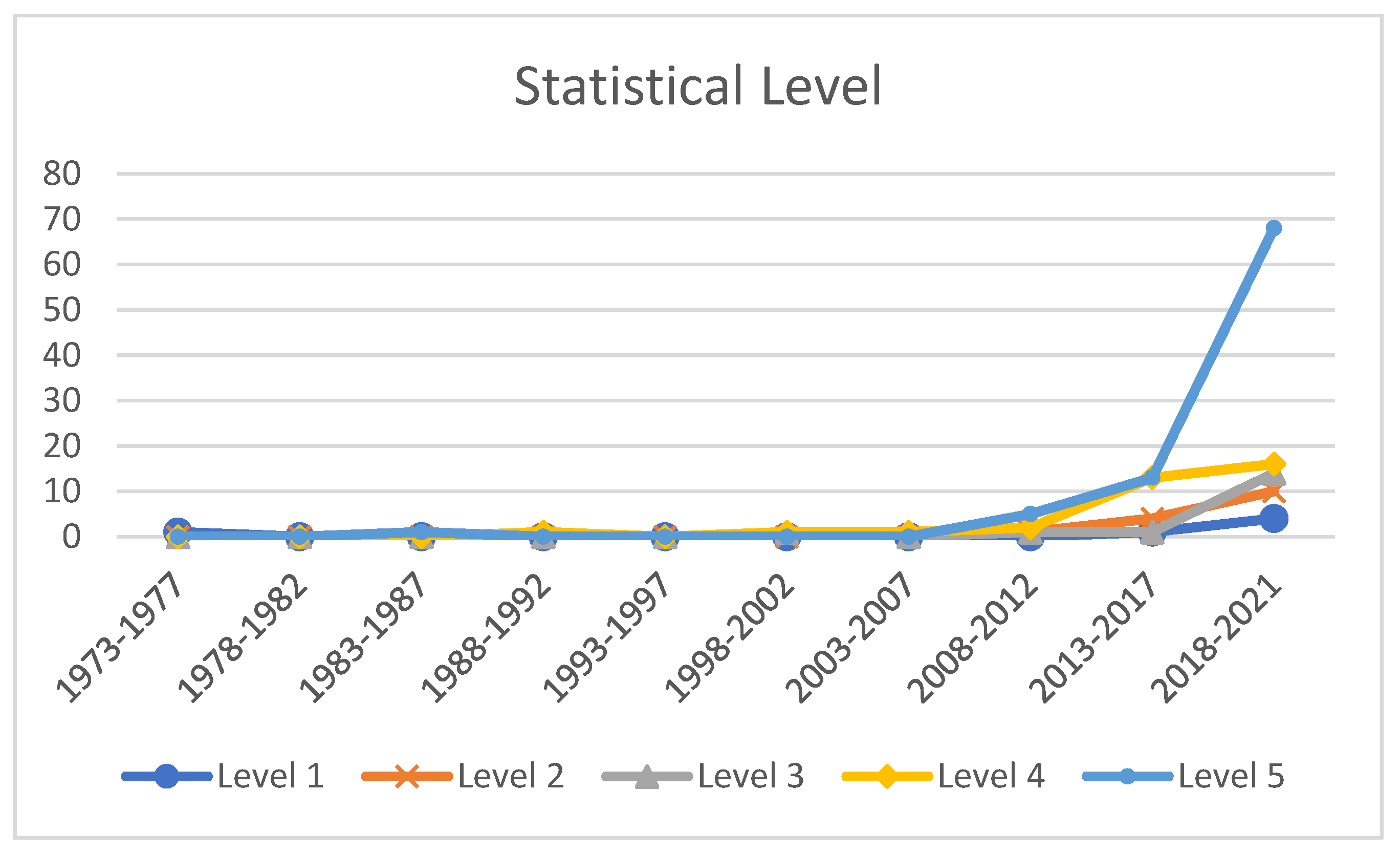
| Mainland China | Hong Kong | India | Israel | Multiple Countries | Turkey | Malaysia | Iran | Pakistan | Philippines | |
|---|---|---|---|---|---|---|---|---|---|---|
| 1973–1977 | 0 | 0 | 1 | 0 | 0 | 0 | 0 | 0 | 0 | 0 |
| 1978–1982 | 0 | 0 | 0 | 0 | 0 | 0 | 0 | 0 | 0 | 0 |
| 1983–1987 | 0 | 0 | 0 | 1 | 0 | 0 | 0 | 0 | 0 | 0 |
| 1988–1992 | 0 | 0 | 0 | 1 | 0 | 0 | 0 | 0 | 0 | 0 |
| 1993–1997 | 0 | 0 | 0 | 0 | 0 | 0 | 0 | 0 | 0 | 0 |
| 1998–2002 | 0 | 0 | 0 | 0 | 1 | 0 | 0 | 0 | 1 | 0 |
| 2003–2007 | 0 | 0 | 0 | 1 | 0 | 0 | 0 | 0 | 0 | 0 |
| 2008–2012 | 1 | 4 | 0 | 1 | 1 | 1 | 0 | 0 | 0 | 0 |
| 2013–2017 | 1 | 10 | 3 | 4 | 1 | 4 | 3 | 2 | 3 | 1 |
| 2018–2021 | 34 | 11 | 14 | 9 | 13 | 9 | 9 | 7 | 3 | 6 |
| Total | 36 | 25 | 18 | 17 | 16 | 14 | 12 | 9 | 7 | 7 |
| Nature | No. & % | Antecedent | No. & % | Consequence | No. & % |
|---|---|---|---|---|---|
| Theory | 35, 20.83% | Contextual | 5, 2.98% | Teacher Personal Outcome | 32, 19.05% |
| Definition | 35, 20.83% | School-level | 68, 40.48% | Teaching Practice | 6, 3.57% |
| Content | 23, 13.69% | Personal | 106, 63.10% | Student Outcome | 4, 2.38% |
| Model | 3, 1.79% | - | - | School Level Outcome | 2, 1.19% |
| Measures | 5, 2.98% | - | - | - | - |
| Total | 68, 40.48% | - | 140. 83.33% | - | 41, 24.4% |
| Level | Description |
|---|---|
| 1 | Descriptive. The use of numbers to represent central tendencies and/or variability of scores. |
| 2 | Single causal factor–correlational. The examination of the relationship or association between two variables, one of which presumably co-varies with or influences the other. |
| 3 | Single causal factor–correlational with controls. The examination of the relationship between two variables while controlling for the influence of one or more other variables. |
| 4 | Multiple factors. This involves probing the differential effects of multiple sources of influence on a particular variable. |
| 5 | Advanced modelling. This comprises tests that explore relationships among multiple independent and dependent variables in a manner that allows for the examination of moderating and/or mediating effects. |
| Interview | Qualitative Survey | Classroom Observation | Case Study | Reflective Reports | Journal Writing | |
|---|---|---|---|---|---|---|
| 1973–1977 | 0 | 0 | 0 | 0 | 0 | 0 |
| 1978–1982 | 0 | 0 | 0 | 0 | 0 | 0 |
| 1983–1987 | 0 | 0 | 0 | 0 | 0 | 0 |
| 1988–1992 | 0 | 0 | 0 | 0 | 0 | 0 |
| 1993–1997 | 0 | 0 | 0 | 0 | 0 | 0 |
| 1998–2002 | 0 | 0 | 0 | 0 | 0 | 0 |
| 2003–2007 | 1 | 0 | 0 | 0 | 0 | 0 |
| 2008–2012 | 0 | 0 | 0 | 0 | 0 | 0 |
| 2013–2017 | 4 | 0 | 1 | 0 | 0 | 0 |
| 2018–2021 | 11 | 2 | 1 | 1 | 1 | 1 |
| Total | 16 | 2 | 2 | 1 | 1 | 1 |
Publisher’s Note: MDPI stays neutral with regard to jurisdictional claims in published maps and institutional affiliations. |
© 2022 by the authors. Licensee MDPI, Basel, Switzerland. This article is an open access article distributed under the terms and conditions of the Creative Commons Attribution (CC BY) license (https://creativecommons.org/licenses/by/4.0/).
Share and Cite
Yu, D.; Chen, J.; Li, X.; Yan, Z. Trajectory of Teacher Well-Being Research between 1973 and 2021: Review Evidence from 49 Years in Asia. Int. J. Environ. Res. Public Health 2022, 19, 12342. https://doi.org/10.3390/ijerph191912342
Yu D, Chen J, Li X, Yan Z. Trajectory of Teacher Well-Being Research between 1973 and 2021: Review Evidence from 49 Years in Asia. International Journal of Environmental Research and Public Health. 2022; 19(19):12342. https://doi.org/10.3390/ijerph191912342
Chicago/Turabian StyleYu, Dongqing, Junjun Chen, Xinlin Li, and Zi Yan. 2022. "Trajectory of Teacher Well-Being Research between 1973 and 2021: Review Evidence from 49 Years in Asia" International Journal of Environmental Research and Public Health 19, no. 19: 12342. https://doi.org/10.3390/ijerph191912342
APA StyleYu, D., Chen, J., Li, X., & Yan, Z. (2022). Trajectory of Teacher Well-Being Research between 1973 and 2021: Review Evidence from 49 Years in Asia. International Journal of Environmental Research and Public Health, 19(19), 12342. https://doi.org/10.3390/ijerph191912342






